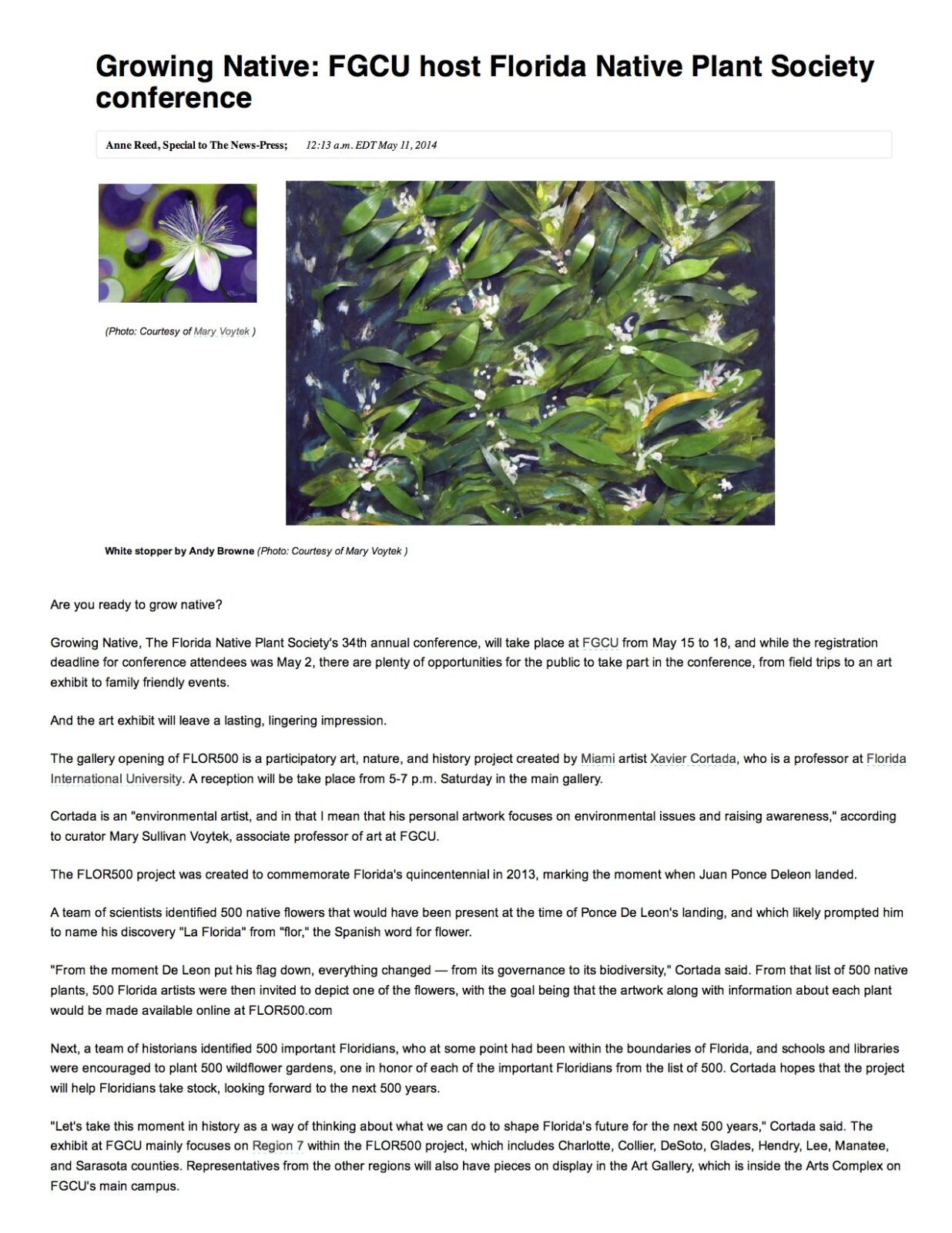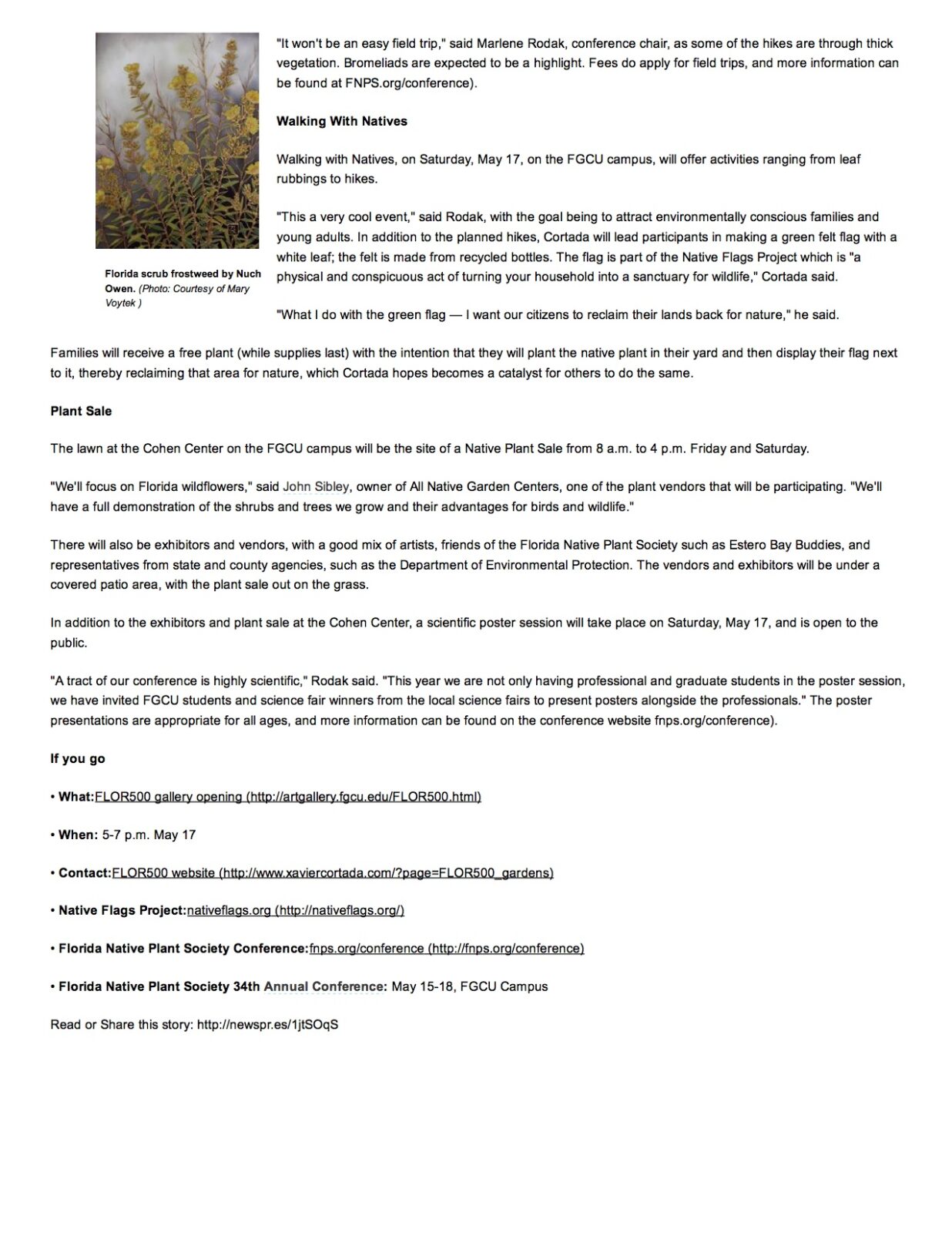


Are you ready to grow native?
Growing Native, The Florida Native Plant Society’s 34th annual conference, will take place at FGCU from May 15 to 18, and while the registration deadline for conference attendees was May 2, there are plenty of opportunities for the public to take part in the conference, from field trips to an art exhibit to family friendly events.
And the art exhibit will leave a lasting, lingering impression.
The gallery opening of FLOR500 is a participatory art, nature, and history project created by Miami artist Xavier Cortada, who is a professor at Florida
International University. A reception will be take place from 5-7 p.m. Saturday in the main gallery.
Cortada is an “environmental artist, and in that I mean that his personal artwork focuses on environmental issues and raising awareness,” accordingto curator Mary Sullivan Voytek, associate professor of art at FGCU.
The FLOR500 project was created to commemorate Florida’s quincentennial in 2013, marking the moment when Juan Ponce Deleon landed.
A team of scientists identified 500 native flowers that would have been present at the time of Ponce De Leon’s landing, and which likely prompted him to name his discovery “La Florida” from “flor,” the Spanish word for flower.
“From the moment De Leon put his flag down, everything changed — from its governance to its biodiversity,” Cortada said. From that list of 500 native plants, 500 Florida artists were then invited to depict one of the flowers, with the goal being that the artwork along with information about each plant would be made available online at FLOR500.com
Next, a team of historians identified 500 important Floridians, who at some point had been within the boundaries of Florida, and schools and libraries were encouraged to plant 500 wildflower gardens, one in honor of each of the important Floridians from the list of 500. Cortada hopes that the project will help Floridians take stock, looking forward to the next 500 years.
“Let’s take this moment in history as a way of thinking about what we can do to shape Florida’s future for the next 500 years,” Cortada said. The exhibit at FGCU mainly focuses on Region 7 within the FLOR500 project, which includes Charlotte, Collier, DeSoto, Glades, Hendry, Lee, Manatee, and Sarasota counties. Representatives from the other regions will also have pieces on display in the Art Gallery, which is inside the Arts Complex on FGCU’s main campus.
After opening day, the gallery will be open 10 a.m. to 4 p.m. Monday through Friday, and until 8 p.m. Thursdays. Some of the wildflowers and native plants included in Region 7 are the ghost orchid (Dendrophylax lindenii), which was depicted by Raymond Hernandez, who chose watercolor as his medium;; glade lobelia (Lobelia glandulosa), which was painted with acrylics by Connie S. Killebrew;; and false mastic (Sideroxylon foetidissimum), which was depicted by Michael Workman using spray paint on pre-stretched canvas.
Curator Voytek is also participating in the FLOR500 project and created a piece depicting leatherleaf airplant (Tillandsia variabilis) out of hand-forged alumninum and was instrumental in getting all of the flowers for our region adopted by artists. When it came to her own flower, Voytek shared a common struggle with her fellow artists: finding their native plant or wildflower in real life to study before to creating their works.
“My friends and the people I invited to the project ended up adopting flowers, then they wanted to see the flower, find the flower, search for the flower,” he said. “They wanted to work from life, but had to find pictures on the Internet, find out what their habitats were like. I kept hearing these stories from the artists … I would assure them that it was an artwork, they had creative license. More times than not, I would then get a phone call that they had created the artwork, and all of a sudden their flower popped up in front of them. And it happened to me! I couldn’t find my particular airplant. Lo and behold last month, this teensy airplant in one of my cabbage palms popped up this bloom and it was it!
“It’s very small and sweet. Bright purple with little tufts.”
Another artist on Captiva saw her flowers washing up on shore after finishing her project.
“It’s been a very interesting series of experiences,” Voytek said. She hopes that most of the artists will attend the opening, which is a prime time for viewers to hear stories about the pieces from the artists who created them.
Field Trips
Another way the public can get involved is through field trips, which will be Thursday, May 15, and Sunday, May 18. Many of the trips have sold out already, and include such favorite stops as CREW and the Fakahatchee Strand. One field trip will take adventurous participants to Gator Hole Preserve on Corkscrew Road, which is not typically open to the public.
Conservation 20/20’s Laura Jewel and friends will lead the excursion and take a dozen participants through the preserve, via 4×4 pickups and a few hikes, identifying native wildflowers.
“It won’t be an easy field trip,” said Marlene Rodak, conference chair, as some of the hikes are through thick vegetation. Bromeliads are expected to be a highlight. Fees do apply for field trips, and more information can be found at FNPS.org/conference).
Walking With Natives
Walking with Natives, on Saturday, May 17, on the FGCU campus, will offer activities ranging from leaf rubbings to hikes.
“This a very cool event,” said Rodak, with the goal being to attract environmentally conscious families and young adults. In addition to the planned hikes, Cortada will lead participants in making a green felt flag with a white leaf;; the felt is made from recycled bottles. The flag is part of the Native Flags Project which is “a physical and conspicuous act of turning your household into a sanctuary for wildlife,” Cortada said.
“What I do with the green flag — I want our citizens to reclaim their lands back for nature,” he said.
Families will receive a free plant (while supplies last) with the intention that they will plant the native plant in their yard and then display their flag next to it, thereby reclaiming that area for nature, which Cortada hopes becomes a catalyst for others to do the same.
Plant Sale
The lawn at the Cohen Center on the FGCU campus will be the site of a Native Plant Sale from 8 a.m. to 4 p.m. Friday and Saturday.
“We’ll focus on Florida wildflowers,” said John Sibley, owner of All Native Garden Centers, one of the plant vendors that will be participating. “We’ll
have a full demonstration of the shrubs and trees we grow and their advantages for birds and wildlife.”
There will also be exhibitors and vendors, with a good mix of artists, friends of the Florida Native Plant Society such as Estero Bay Buddies, and representatives from state and county agencies, such as the Department of Environmental Protection. The vendors and exhibitors will be under a covered patio area, with the plant sale out on the grass.
In addition to the exhibitors and plant sale at the Cohen Center, a scientific poster session will take place on Saturday, May 17, and is open to the public.
“A tract of our conference is highly scientific,” Rodak said. “This year we are not only having professional and graduate students in the poster session, we have invited FGCU students and science fair winners from the local science fairs to present posters alongside the professionals.” The poster presentations are appropriate for all ages, and more information can be found on the conference website fnps.org/conference).